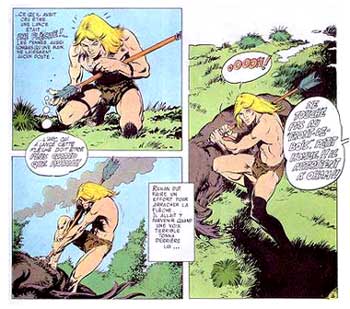Les Pionniers de l'Épérance, artwork by Raymond Poïvet
Roger Lécureux was one of the main writers of realistic comics for Vaillant magazine. Just like Jean Ollivier, he wrote numerous series in several genres, varying from science fiction ('Les Pionniers de l'Espérance') to history ('Rahan'). He started working for the magazine in 1945, when he became in charge of the subscriptions. Soon, he wrote his first comic, 'Fifi Gars du Maquis' for Auguste Liquois. In December 1945 this first effort was followed by one of the most notable series that appeared in Vaillant, 'Les Pionniers de l'Espérance', drawn by Raymond Poïvet. The series ran until 1973.
He multiplied his activities in the late 1940s with series like 'Nasdine Hodja' (art René Bastard, R. Violet and Pierre Leguen), 'Lynx Blanc' (art Claude-Henri and Paul Gillon) and 'Sam Billie Bill' (art Lucien Nortier). All these series became highlights of the magazine and ran for several years. He continued this line of work in the 1950s and 1960s with new series like 'Fils de Chine' (art Paul Gillon), 'Louk' (art Pascal and Max Lenvers), 'Wango' (art E.T. Coelho and Gillon), 'Teddy Ted' (art Yves Roy and Gérald Forton). Roger Lécureux was chief editor of Vaillant magazine from 1958 to 1963.
Sam Billie Bill, artwork by Lucien Nortier
When Vaillant changed to Pif, Lécureux started new series, such as 'Rahan' (art Chéret), 'Capitaine Apache' (art Norma) and several short stories. While being highly productive for Vaillant/Pif, Lécureux also worked for the press. He wrote several comics for L'Humanité, working mostly with artists from the Vaillant team, like Claude-Henri, René Deynis and Jean Cézard, but also with Pellos. He has also scripted several Mon Journal pocket comics.
In 1994 he started 'Le Petit Rahan', a spin-off of his successful series about the caveman Rahan, one of the most popular series from the Pif Gadget era. Since Roger Lécureux's death in 1999, 'Rahan' has been continued by Chéret and Roger's son Jean-François Lécureux in a series of self-published books.
Rahan, artwork by André Chéret





